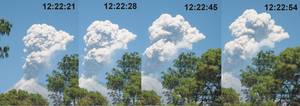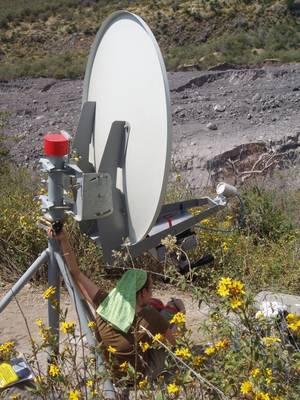Dynamics of vulcanian, subplinian and plinian eruptions
Dynamics of vulcanian, subplinian and plinian eruptions: A case study at Volcán de Colima, Mexico.
Volcán de Colima is currently at its most active stage in almost 100 years. Since 1998 the activity has virtually been continuous and has featured a number of transitions between effusive and explosive activity. The most recent effusive phase was started late in 2004 (for a typical eruption observed in 2007 see Fig. 1). The most recent major plinian eruption occurred in 1913 producing a crater with a depth of 350m and a diameter of 600m (Luhr and Carmichael, 1990). It has been proposed that Volcán de Colima has an approximate 100 year cycle which terminates or starts with a large plinian eruption (Luhr and Carmichael, 1990, Robin et al., 1991) and it seems possible that we have entered a period of activity that is part of the lead up to the next large plinian eruption.
Large explosive volcanic eruptions (see Fig. 1) are usually associated with the generation of large-scale volcanic plumes that penetrate high up into the atmosphere or major pyroclastic flows with some times very large runout distances. Depending on the size of the eruption the plume penetrates to different heights into the atmosphere thereby dispersing volcanic volatiles and ash. Volcanic ash is a major hazard for aviation and in case the rising plume reached the stratosphere volcanic gases can impact the global climate (like the eruption of Mt. Pinatubo in 1991).
In general eruption columns, i.e. volcanic ash clouds, can be divided into three main parts, the so-called gas thrust region, the convective region, and the umbrella region (e.g. Sparks et al, 1997). In the gas thrust region, the erupted mixture is still dense (here the average density is larger than the density of air) and the eruption is mainly driven by inertia, i.e. the dynamics are similar to that of a jet. During this stage the erupted mixture decelerates and entrains ambient air thereby reducing its overall density. Once the amount of entrained air is large enough the density in the eruption column drops below that of the ambient air and the eruption column enters the convective region and rises under its own buoyancy. The transition height is highly variable and is mainly controlled by the mass flux at the vent. If the transition height is not reached the eruption column collapses thereby producing pyroclastic flows. In the umbrella region the eruption column decelerates again and spreads out laterally. At the top of the umbrella region the vertical velocity is zero.
In this project we want to explore the physics of plinian eruptions through carrying out vent near in situ measurements of eruption dynamics. To accomplish this we will permanently install a Doppler radar instrument at Volcán de Colima, México (see Fig. 2). The Doppler radar measures the amount and velocities of the erupted ash, similar to speed traps used by the police. The instrument will be tied into the observational network at Colima and aside from the scientific questions we are going to address, the instrument will be used as an additional tool to assess the activity status of Colima volcano. Here, the velocity and the amount of erupted ash will be used as initial conditions in 3D numerical models. The model results will then be compared a) to visual observations of the different eruptions and b) with the dynamics observed higher up in the eruption cloud using a second instrument. The data which are collected with the instruments will then be used in different atmospheric models to see how well these models reproduce the temporal evolution of the eruption column.
Funding: German Science Foundation 2008-2010
Contact: Lea Scharff or Matthias Hort

- Top: Photo sequence of a bigger eruption on March 2, 2007. Time is local time.

